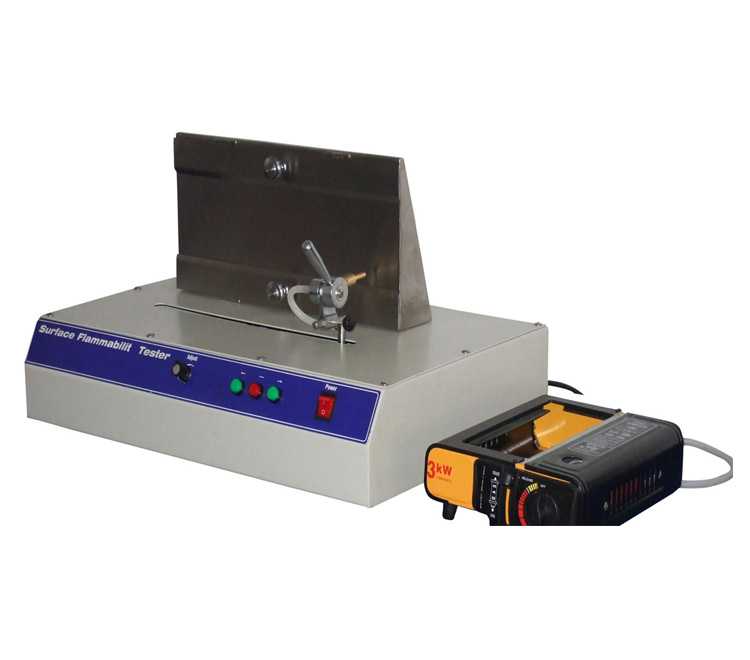The structure of the surface flammability tester
The fabric surface burning performance tester is designed with the latest technology and is suitable for measuring the fabric surface burning time of fluffy textiles. There are different accessories for GB/T 8745-2001 Textiles and ISO 10047:1993 Textiles Fabric Surface Burning Time Determination.

The surface flammability tester usually consists of the following parts:
Combustion system
- **Burners**: It is the core component that produces flames. It is generally made of metal materials, such as brass, and has good high temperature resistance and corrosion resistance. Its nozzle aperture is usually small. For example, the burner nozzle aperture of the building material flammability tester is ¢0.17mm, which allows the gas to be ejected at a certain pressure and speed to form a stable flame.
- **Gas supply device**: Including gas bottles, pressure reducing valves, solenoid valves, etc., to provide a stable gas source for the burner, and can adjust the gas pressure and flow to ensure that the size and intensity of the flame meet the test requirements.
Mechanical transmission system
- **Drive motor and transmission components**: Such as screws, worm gears, belts, etc., used to drive the burner or sample fixture and other components to move at the set speed and method to achieve combustion tests on different positions on the sample surface.
- **Guide rails and sliders**: Provide guidance and support for the burner or other moving parts to ensure the smoothness and accuracy of their movement. High-precision linear guide rails and sliders are usually used to reduce friction and shaking.
Control system
- **Control circuit**: Use board card + microcomputer control and other methods to realize automatic control of the test process, including setting and adjusting parameters such as burning time, flame height, burner movement speed, and receiving and processing signals from sensors.
- **Operation panel**: Equipped with an intuitive operation interface, usually an LCD screen and buttons or a touch screen, which is convenient for users to set parameters, test operations and view data.
- **Data acquisition and processing unit**: Real-time collection and recording of relevant data during the test, such as flame height, burning time, degree of damage of the sample, etc., and data processing and analysis are performed to generate test reports or curves.
Specimen fixtures and fixtures
- **Fixture**: Designed according to different specimen shapes and sizes, such as flat fixtures, columnar fixtures, etc., mechanical clamping or pneumatic clamping is used to ensure that the specimen is firmly fixed during the test without movement or shaking.
- **Sample holder**: used to support and place the sample fixture, usually with adjustable height and angle to meet different test requirements.
Observation and measurement device
- **Observation window**: generally made of high temperature resistant glass, installed on the box or shell of the tester, so that the operator can observe the burning condition of the sample in real time during the test.
- **Measuring tool**: equipped with flame height scale, sample damage degree measuring scale and other measuring tools, used to accurately measure and evaluate the burning effect of the sample after the test.
Technical Parameters
1. Sample holder: L 150mm×W 75mm
2. Frame marker line: 75mm below the sample ignition place.
3. Ignition time: 0~99.99s, arbitrarily set.
4. Flame height measuring device: Flame height 40±2mm.
5. Distance from the top of the ignitor to the surface of the sample holder: 15mm.
6. Applied gas: Industrial butane or propane or butane/propane mixed gas.
7. Sample size: 150mm×75mm

